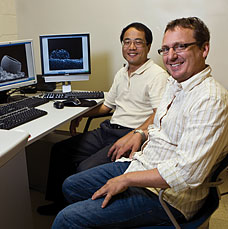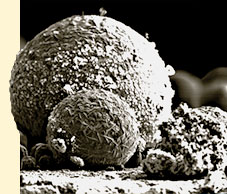Tiny Landscapes of Unseen Worlds

Inner Space, a grand-scale exhibit featuring molecular-scale subjects, is the result of an unusual collaboration between two UGA professors: artist Michael Oliveri and materials scientist and engineer Zhengwei Pan. Inspired by the nanostructures—measured in nanometers, or billionths of a meter—created by Pan and his postdoctoral researchers Zanjun Fu and Feng Liu, Oliveri created six sweeping (3-foot by 9-foot) photographic interpretations of their research. Through his work, Oliveri has sought to bring these tiny structures, invisible to the naked eye, into sharp focus for all to see.
Using the powerful electron microscope in Pan’s lab, Oliveri searched through hundreds of original data images, selecting those he thought would work as horizontal “landscapes.” Each huge black-and-white print comprises some 40 individual scans, magnified from 2,000 to 30,000 times their actual size and painstakingly pieced together.
“When you look at these images, your mind is working to make sense of them,” says Oliveri. “Most people approach them with a common landscape vernacular and then are struck with a sense of confusion. I look at them with a sense of the sublime—a contradiction that you finally have to accept.”
Nanostructures, fabricated in shapes such as rods, tubes, particles—and belts, which Pan was the first to create, are already used to enhance the performance of stain-resistant clothing, protective coatings, and some other products. But that’s just the beginning. Nanotechnology’s advance offers the possibility of many more nanoscale products—with unique physical, chemical, or biological properties—for use in communications, medicine, transportation, agriculture, and manufacturing.


Oliveri’s keen interest in science and technology is inspired by what’s new—and especially by what’s coming. “What Zhengwei is doing and creating in his lab will affect what my five-year-old daughter’s life will be like one day,” says Oliveri.
When he first met Pan, Oliveri said he was struck by the similarities in how they work. “When Zhengwei goes into the lab each day, he uses different materials, under various pressures and temperatures, and he doesn’t know exactly what the outcome will be,” says Oliveri. “It’s a fascinating creative process, common to both the arts and the sciences, that allows unexpected things to happen.” Even the professors’ workspaces are similar, looking more like workshops—with arrays of power tools and toolboxes—than studios or research labs.
Inner Space landscapes were on exhibit at the Chicago Art Fair earlier this year and at UGA’s Lamar Dodd School of Art galleries in April and May. The exhibit has been purchased by Regents Partners, an Atlanta-based company, to hang in its 50-story Sovereign building in Buckhead.
For more information, contact Michael Oliveri at: moliveri@uga.edu
 |


